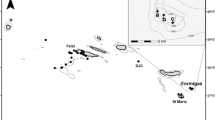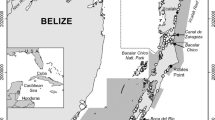Abstract
Between June 1994 and September 1996, a mark–recapture study was conducted in the Hinchinbrook Channel area of tropical northeastern Australia to investigate the movements of the sparid fish Acanthopagrus berda. A total of 962 A. berda were tagged, 922 within a single estuary system, Deluge Inlet. No movements among estuaries were detected. Of the fish tagged in Deluge Inlet, 12.9% were recaptured. Two movement regimes were detected: local movements (mostly <500 m) during non-spawning times, and longer migrations (up to 3.12 km) during spawning seasons, to and from a spawning site at the estuary mouth. Although there appeared to be a major spawning aggregation in the mouth of Deluge Inlet, ripe female A. berda were present in upstream sites, indicating that spawning probably occurs there also. This contrasts to the situation in South Africa, where A. berda is reported to spawn only close to estuary mouths. Differences such as this highlight our limited knowledge of variations in the reproductive biology of widespread species such as A. berda.
Similar content being viewed by others
Author information
Authors and Affiliations
Additional information
Received: 25 November 1997 / Accepted: 10 September 1998
Rights and permissions
About this article
Cite this article
Sheaves, M., Molony, B. & Tobin, A. Spawning migrations and local movements of a tropical sparid fish. Marine Biology 133, 123–128 (1999). https://doi.org/10.1007/s002270050450
Issue Date:
DOI: https://doi.org/10.1007/s002270050450




